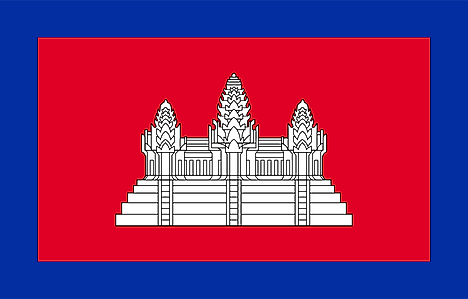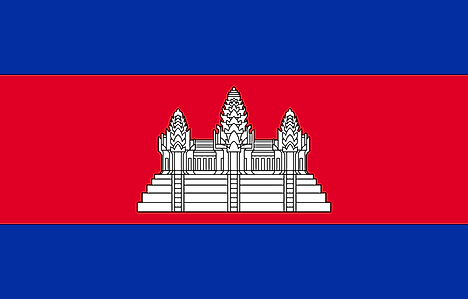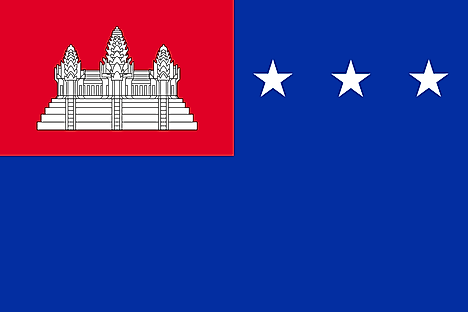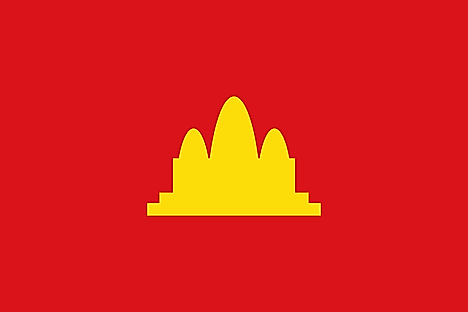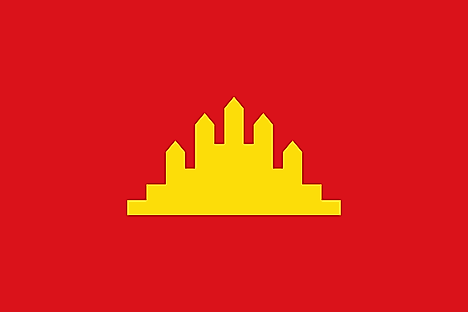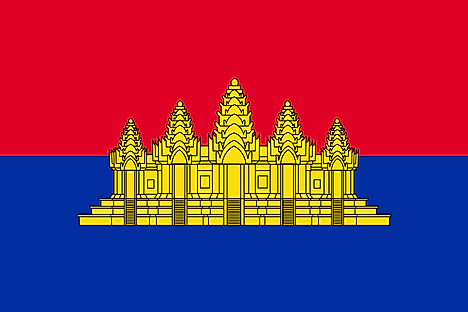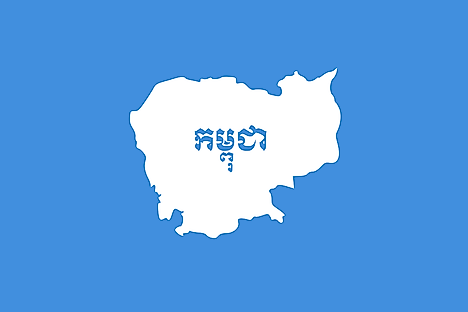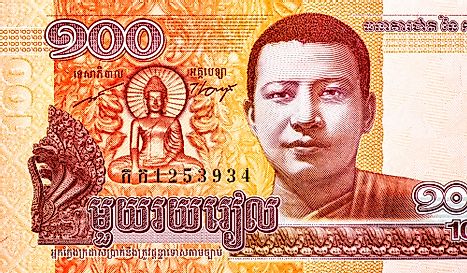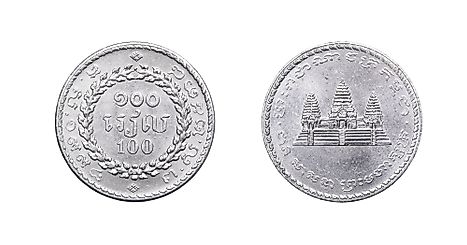Flags, Symbols, & Currencies of Cambodia
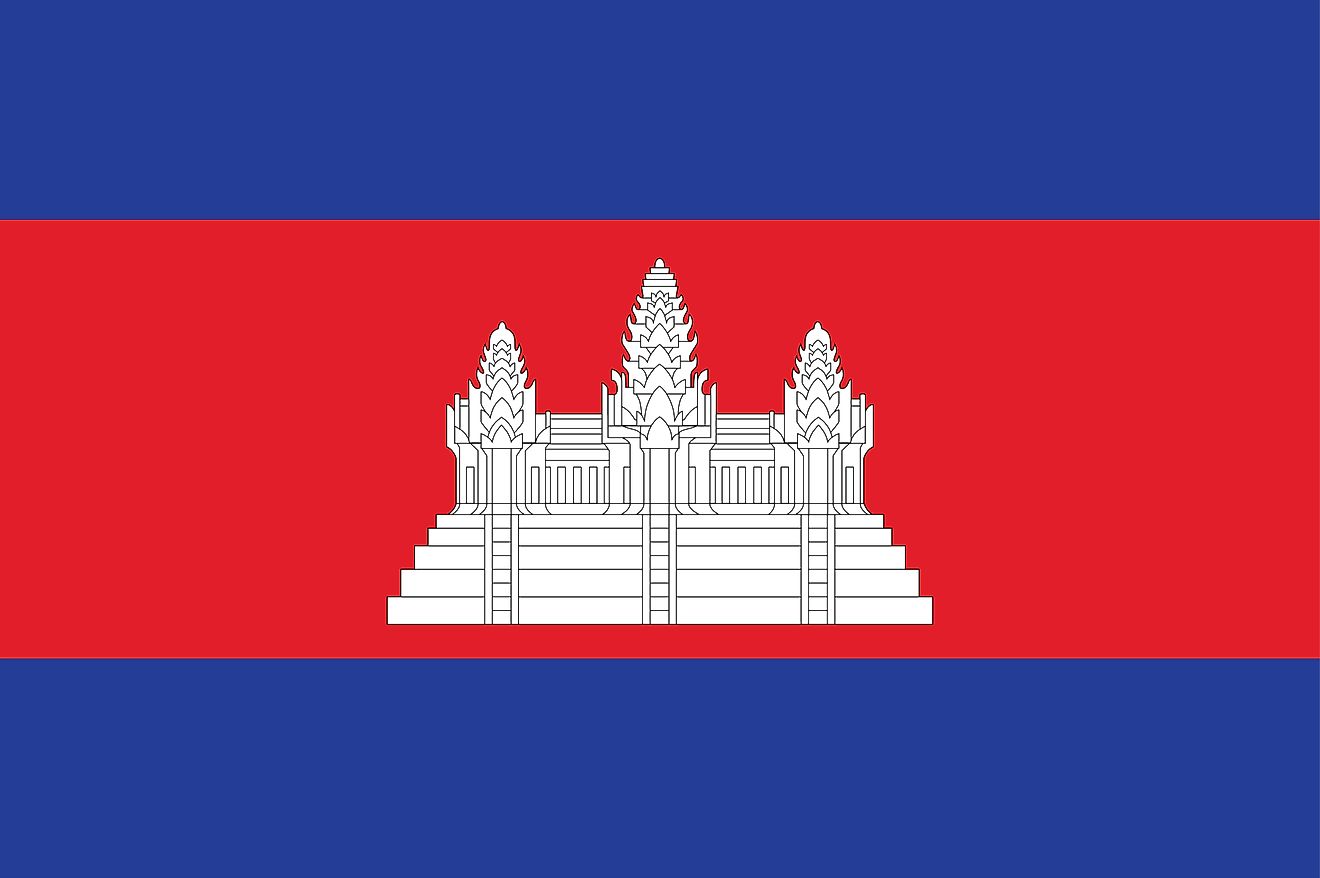
The flag of Cambodia is one of the country’s national emblems. Also known as the “Khmer,” Cambodia’s national flag was first used between 1948 and 1970, and later reintroduced in 1993. The reintroduction of the flag coincided with the reinstitution of monarchy in Cambodia and the election of the nation’s Constituent Assembly in 1993.
The flag of Cambodia is designed on a horizontal rectangular shape whose officially recognized length-width ratio is 25:16. The flag features a horizontal tri-band made up of two colors: red and blue. There are two blue bands, one at the top and another at the bottom, with a red band in the middle that is twice as thick as the blue bands. A white depiction of the Angor Wat temple is centered on the red band.
A previous design of the flag came in the form of a vertical rectangle. The design featured a tri-band of red and blue stripes, which ran vertically. In this design, the two blue bands are located on the flag’s hoist and fly side, while the red double-width band runs in the middle. The Angkor Wat temple was centered on the middle red band.
Colors and Symbols
The meaning behind the colors and symbols of Cambodia's flag are all inspired by the country's cultural beliefs. Red is said to represent the bravery of the Cambodian nation. The color also represents the dominant religion in the country, which is Buddhism. White also represents the country’s religious beliefs and the virtue of purity. The blue color is said to represent a sense of brotherhood, cooperation, and unity among the Cambodian people. Blue can also represent the royalty of the country’s monarchy. Red and blue were essential colors during the era of Cambodia’s Khmer Empire. The temple on the flag’s center represents the Angkor Wat, a 12th century temple of great spiritual and cultural importance among Cambodians.
Other Flags
Another flag officially recognized and used in Cambodia is the Royal Standard. The Royal Standard is the official flag of the country’s monarch and is recognized as a national symbol in Cambodia. The royal flag is made up of the royal arms symbol centered on a blue field. The blue color represents the royalty of the monarchy.
History of the Flag of Cambodia
Cambodia has adopted a total of 10 different flags over the course of its history since the mid-19th century. The current flag was first adopted in 1948 when Cambodia was still a French protectorate, and was retained after the country gained self-rule from France in 1953. However, the flag was replaced in 1970 after the establishment of the Khmer Republic. Since then, the country adopted six other national flags, including the United Nations Transitional Authority in Cambodia (UNTAC) flag, used between 1992 and 1993, until the “Khmer” was reintroduced in 1993, when the country reverted to a monarchy.
Symbols of Cambodia
National Coat of Arms of Cambodia
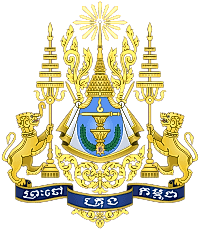
The Royal arms of Cambodia or Cambodia's coat of arms is composed of two lions, one with an elephant trunk and the other a rajasingha (royal lion). The two lions hold onto royal five-tiered umbrellas symbolizing the King and Queen, and stand on top of a blue ribbon displaying the phrase 'Preah Chao Krung Kampuchea' (King of the Kingdom of Cambodia). A royal crown is situated between the lions, with an Unalome sign beneath it and a ray of light on top.
National Anthem
- Anthem Title: Nokor Reach
- Music composer: Norodom Suramarit
- Lyricist: Chuon Nath
- Date of Adoption: 1941 (readopted in 1993)
Nokor Reach (Majestic Kingdom or Royal Kingdom) is Cambodia's national anthem, adopted in 1941 and readopted in 1993. It was written by Chuon Nath and based on one of the country's folk tunes. Norodom Suramarit composed the music of Nokor Reach between 1938 and 1939. When the Mornachy was abolished in 1970, the anthem was replaced as well. It was reinstated briefly in 1975 then replaced with "Dap Prampi Mesa Chokchey" by Khmer Rouge, used until 1993.
Nokor Reach
សូមពួកទេព្តា រក្សាមហាក្សត្រយើង
អោយបានរុងរឿង ដោយជ័យមង្គលសិរីសួស្តី
យើងខ្ញុំព្រះអង្គ សូមជ្រកក្រោមម្លប់ព្រះបារមី
នៃព្រះនរបតីវង្ស ក្សត្រាដែលសាងប្រាសាទថ្ម
គ្រប់គ្រងដែនខ្មែរ បុរាណថ្កើងថ្កាន។
ប្រាសាទសិលា កំបាំងកណ្តាលព្រៃ
គួរអោយស្រមៃ នឹកដល់យសស័ក្តិមហានគរ
ជាតិខ្មែរដូចថ្ម គង់វង្សនៅល្អរឹងប៉ឹងជំហរ
យើងសង្ឃឹមពរ ភ័ព្វព្រេងសំណាងរបស់កម្ពុជា
មហារដ្ឋកើតមាន យូរអង្វែងហើយ។
គ្រប់វត្តអារាម ឮតែសូរស័ព្ទធម៌
សូត្រដោយអំណរ រំឭកគុណពុទ្ធសាសនា
ចូរយើងជាអ្នក ជឿជាក់ស្មោះស្ម័គ្រតាមបែបដូនតា
គង់តែទេវតា នឹងជួយជ្រោមជ្រែងផ្គត់ផ្គង់ប្រយោជន៍ឱ្យ
ដល់ប្រទេសខ្មែរ ជាមហានគរ។
Royal Kingdom
May the Angels save our king
Granting him happiness and prosperity
We, his servants, wish to refuge under his completeness
Of sovereign's line, ones being to build temples
Reigning over old Khmer's glorious land.
Temples of stone, hidden amid forests
Bethought of the mighty Maha Nokor's triumphs
Khmer race stands tough and solid as eternal stone
We pray for the best upon Kampuchea's destiny
A grand nation've ever occurred for.
Dharma risen, up from monasteries
Chant with joy, commemorate of Buddhism
Let us be faithful to our ancestors' belief
Assuredly, Angels will grant its bounty
Toward Khmer's, the grand nation.
The Currency of Cambodia is the Cambodian riel
Cambodia gained independence from France in 1953. In the same year, the Bank of Cambodia minted and issued riel in different denominations. The currency was divided into units of 100 centimes. The round coins used as currency were made of aluminum. Cambodian riel was used alongside the piaster as the legal tender of Cambodia. However, piaster slowly lost popularity to the riel, and by the end of 1955, the piaster was no longer in circulation. The use of Cambodian riel as legal tender was temporarily halted in 1975 when Khmer Rouge took up leadership of Cambodia.
Khmer Rouge Period
When the Khmer Rouge movement took charge of Cambodia, the brutal leader Pol Pot abolished all forms of currency in Cambodia. He enforced communal living where people shared all resources. The people of Cambodia resorted to barter trade. Although bank notes continued to be produced, the notes were never released to the public. Cambodia’s economy greatly suffered under the Khmer Rouge regime.
Re-establishment of the riel
When Vietnamese forces invaded Cambodia in 1978, they removed Khmer Rouge from leadership. The Cambodian riel was re-introduced into the economy in 1980. At the time, the economy of Cambodia was already in tatters. Cambodian authorities freely gave out the riel to Cambodians to boost its use. In today’s Cambodia, the riel is still the official legal tender. However, many Cambodians use the US dollar in trading activities. People who live in towns that border Thailand and Vietnam commonly use the Thai baht and the Vietnamese dong. The banknotes are minted in the denominations of 100, 500, 1,000, 2,000, 5,000, 10,000, 20,000, and 50,000 riels.
Historical Currencies of Cambodia
In medieval times, business was thriving in Cambodia. During the reign of the Khmer empire, businesspeople from Greece, India, Iran, Malaysia, and Rome came to trade in Cambodia. The merchants used coins made of gold, silver, and bronze as their currency. In addition to metallic currency, the merchants regularly engaged in barter trade. They swapped corn, beans, and rice for fish, goats, and farmland. As a result of the trades, Cambodia’s economy and its foreign relations significantly improved. The progressive trend went on until 1867 when the French colonized Cambodia. French authorities introduced their currency to the Cambodian economy. The colonizers started a bank in Cambodia’s capital city, Phnom Penh, where they printed paper currency and distributed it throughout Cambodia. The Kingdom of Cambodia has an interesting monetary past. The country used a variety of currencies throughout its many years of trade. The currencies varied in their make, size, and shape, ranging from precious metal coins to ceramics. Currently, the South Asian country uses the riel as its official currency. The currency’s name is said to have emerged from the popularly used Mexican real. The real was common during 19th-century trade with Indian, Chinese, and Malay traders.
